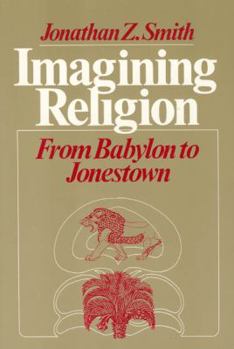Imagining Religion: From Babylon to Jonestown
Select Format
Select Condition 
Book Overview
With this influential book of essays, Jonathan Z. Smith has pointed the academic study of religion in a new theoretical direction, one neither theological nor willfully ideological. Making use of examples as apparently diverse and exotic as the Maori cults in nineteenth-century New Zealand and the events of Jonestown, Smith shows that religion must be construed as conventional, anthropological, historical, and as an exercise of imagination...
Format:Paperback
Language:English
ISBN:0226763609
ISBN13:9780226763606
Release Date:May 1988
Publisher:University of Chicago Press
Length:180 Pages
Weight:0.60 lbs.
Dimensions:0.4" x 6.1" x 9.0"
Customer Reviews
1 rating
Analytical genius
Published by Thriftbooks.com User , 21 years ago
Jonathan Z. Smith is the enfant terrible of the History of Religions discipline, although he's no longer young. From his first essays (collected in Map Is Not Territory) to his more recent musings in To Take Place and Drudgery Divine, he has outraged, stimulated, challenged, and restructured the study of religion in the modern academy.Each essay here is a little gem, and should be read and savored by any serious student. Right at the start, in "Fences and Neighbors", Smith shows his true colors: he talks about the taxonomy of walnuts, and uses this as a startlingly perfect demonstration of the strengths and weaknesses of various ways of defining and categorizing religion, religions, and religious groups. "In Comparison a Magic Dwells" points out that most comparison falls into Frazer's homeopathic/contagious magic division, and demonstrates the various pitfalls of the comparative endeavor. I could go on, right through the devastating and terrifying analysis of the Jonestown White Nights mass suicide, in which Smith argues that to study religion seriously, we have a duty to recognize that it is not always "nice," not always about love and peace, and that sometimes awful things are done because of religious feeling, but that nevertheless we are required to try to make sense of it -- a lesson that has renewed force in the wake of 9/11.Smith does have one real flaw, though, which is that he assumes that everyone is as intelligent and careful as he is. He thinks that every reader will read all the endnotes, for example, and think about their implications for his arguments. And he assumes that every reader will hang onto a certain common-sense perspective on human nature, and interpret his arguments in that light.Unfortunately, this isn't always the case. "In Comparison a Magic Dwells," for example, argues the need for a radical rethinking of how comparison should be done; many readers, however, think that he is anti-comparison in general. "The Bare Facts of Ritual," which tries to uproot an old sympathetic-magic reading of certain kinds of hunting rituals, and by implication a broader range of apparently intrumental rituals, has been interpreted as a failed attempt at a complete theory of ritual.In short, this whole book needs to be read again and again, notes and all, with extraordinary care. If you're not willing to put in a great deal of effort, just don't bother--you're going to come out thinking that Smith has nothing constructive to say.In _Imagining Religion_, Smith is by turns devastating and hilarious, and always brilliant. Not all of it can withstand every possible criticism, but what can? A seminal work, _Imagining Religion_ marks a place at which the History of Religions must either turn or turn back; the very possibility of the study of religion depends upon our turning.





